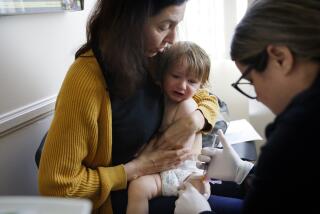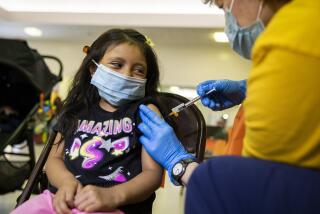Great idea, but delivery is tough
- Share via
Rapid, mass vaccination of the young presents a new logistical problem, one that many communities aren’t yet able to solve.
“There are really two avenues to do this,” says Dr. Peter Szilagyi, a pediatrician and expert in child immunizations at the University of Rochester Medical Center. “One is to grab every child when they are already there [at the doctor’s office], use reminder mechanisms to bring people in and have special hours like weekends and evenings -- just make it very efficient. The other path is to think about using schools or other places for vaccination.”
Some county health departments and school districts are doing just that.
“It’s an appealing way to reach children,” says Dr. Jeanne Santoli of the CDC. “But the primary business of schools is education. Schools don’t want that to be compromised, and physicians don’t want that to be compromised.”
More than 30 of California’s 58 counties will offer some form of school-based flu vaccine clinics this year, says John Talarico of the California Department of Health Services, up from 18 last year.
But a 2004 pilot study using schools to provide flu vaccination in San Bernardino County revealed the complexity of such an approach, says Dr. Gerald R. Greene, a pediatrician in Highland who helped coordinate the study.
The project required detailed planning, coordinated schedules and a multitude of volunteers, he says. Further, it was difficult to provide the immunization to students in the junior high and high schools because they change classrooms throughout the day and have busy schedules.
Even vaccinating elementary school children was a challenge, Greene says. Parental consent had to be obtained. And children under age 9 who were being vaccinated for the first time needed two doses of vaccine, which required a second trip to the school.
“Trying to bring vaccine to that many schools in a short amount of time requires effort and personnel that would go beyond those supplied by most school districts,” Greene says.
Other health experts say families should turn to their regular doctor. “We think the best place for kids to get vaccinations is with the primary care provider,” says Dr. Jonathan Fielding, director of L.A. County’s Department of Public Health. “This should not require specialized care.”
The CDC, however, wants to make vaccination more accessible. Store-based clinics are one option, and the company that runs Minute Clinics, located in CVS drug stores, recently changed its policy to provide flu vaccines to children as young as 18 months. The previous policy required a child to be at least 4 years old.
The CDC also suggests that flu vaccination continue through the holidays instead of the typical October-through-November schedule. Studies since 1968 have shown that, 80% of the time, flu cases reach a peak in January or later, and 60% of the time in February or later.
More flu clinics should be aimed at families, experts note. Some HMOs, such as Kaiser Permanente, offer special flu shot clinics for its members of all ages throughout the flu season -- often on weekends.
Unlike the Minute Clinics at CVS, most pharmacies will not vaccinate children under middle-school age.
Considering the nation’s goal of delivering flu shots to more than 80% of Americans, it needs more places where mom, dad, the kids and grandparents could walk in, get the vaccine in a few minutes and be done with it, experts acknowledge.
But, as Talarico points out: “We don’t do one-stop shopping with our healthcare. Women go to the gynecologist, children go to the pediatrician, other family members go to a general practitioner. It’s a reflection of our current medical care system.”
More to Read
Sign up for Essential California
The most important California stories and recommendations in your inbox every morning.
You may occasionally receive promotional content from the Los Angeles Times.













